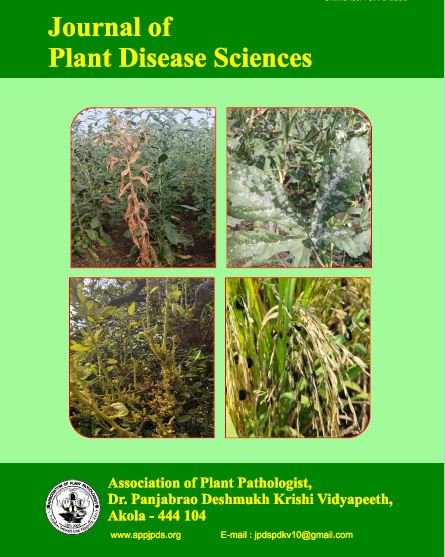EVALUATION OF BIOPOLYMER-BASED TRICHODERMA AND ACTINOMYCETES AGAINST WILT AND ROOT ROT COMPLEX OF SAFFLOWER
DOI:
https://doi.org/10.48165/jpds.2024.19.02.11Keywords:
Safflower, Wilt, Fusarium oxysporum, Macrophomina phaseolina, Trichoderma, BioagentsAbstract
Safflower (Carthamus tinctorius) is an annual oilseed crop valued for its high-quality oil used in food, cosmetics, and industrial applications. Native to the Mediterranean region, safflower is now widely cultivated, with Maharashtra being a key producer in India. However, its production is significantly impacted by wilt disease, caused by Fusarium oxysporum f. sp. carthami, and root rot, caused by Macrophomina phaseolina, both of which lead to plant mortality, reduced seed yield, and inferior oil quality.This study focuses on the biological management of these diseases using biopolymer-based Trichoderma and actinomycetes. In in vitro experiments, biopolymer-based Trichoderma harzianum exhibited the highest inhibition of Fusarium oxysporum (mean colony diameter: 27.00 mm), followed by Trichoderma harzianum (42.30 mm). Similarly, Macrophomina phaseolina was significantly suppressed by Trichoderma harzianum (29.33 mm) and Trichoderma asperellum (30.33 mm), which performed at par, followed by Trichoderma koningii (34.33 mm) and biopolymer-based Trichoderma harzianum (47.50 mm).Field studies demonstrated that seed treatment with biopolymer-based Trichoderma at 10 ml/kg seed combined with soil application at 100 ml/5 L water per plot significantly reduced wilt and root rot incidence compared to other bioagents.References
Ahmad, I., & Khan, M.R., 2024. Bioefficacy of indigenous isolates of biocontrol fungi and bacteria against Macrophomina phaseolina causing root rot disease in green gram. Microbiology Research Journal International, 34(6): 1–10.
Cao, L., Qui, Z., Dai, X., Tan, H., Lin, Y., & Zhou, H., 2004. Isolation of endophytic Actinomycetes from roots and leaves of banana (Musa acuminata) plants and their activities against Fusarium oxysporum f. sp. cubense. World Journal of Microbiology and Biotechnology, 20: 501–504.
Diaz-Diaz, M., Bernal-Cabrera, A., Trapero, R., Medina-Marrero, A., Sifontes Rodriguez, R.D., Cupull-Santana, S., Garcia-Bernal, M., & Agustí-Brisach, C., 2022. Characterization of Actinobacterial strains as potential biocontrol agents against Macrophomina phaseolina and Rhizoctonia solani, the main soil-borne pathogens of Phaseolus vulgaris in Cuba. Plants, 11: 645.
Raghuchander, T., Rajappan, K., & Samippan, R., 1997. Evaluating methods of application of biological agents in the control of mungbean root rot. Indian Phytopathology, 50(2): 229-234.
Sajeena, A., Salalrajan, F.K., Seetahraman, K., Eraivan, R., & Mohanbabu, R., 2003. Biological control of root rot of black gram (Phaseolus mungo) caused by Macrophomina phaseolina (Tassi.) Goid. National Seminar on IPDMSA, Annamalai University, Abstract, pp. 30.
Sakure, S., Limbore, A.M., Zalake, S., & Jaigude, M., 2015. Isolation and characterization of Actinomycetes from rhizosphere soil of different plants for antiphytopathogenic activity and stress tolerance. International Journal of Current Microbiology and Applied Sciences, Special Issue-2: 379-387.
Singh, S., Varma, P., & Chand, H., 2008. Evaluation of fungal antagonists against Macrophomina phaseolina causing root rot of mungbean. Legume Research, 30(3): 229-230.
Wang, S., Liang, Y., Shen, T., Yang, H., & Shen, B., 2016. Biological characteristics of Streptomyces albospinus CT 205 and its biocontrol potential against cucumber Fusarium wilt. Biocontrol Science and Technology, 26(7): 951-963.
Citation: Shinde, S.P., Ambadkar, C.V., Falke, S.A., & Nirwal, K.P., 2024. Evaluation of biopolymer-based Trichoderma and Actinomycetes against wilt and root rot complex of safflower. J. Pl. Dis. Sci., 19(2): 149-154. DOI: https://doi.org/10.48165/jpds.2024.19.02.11.

